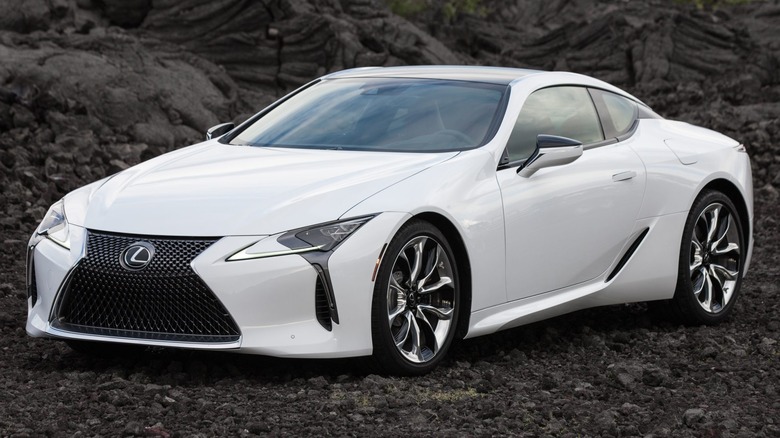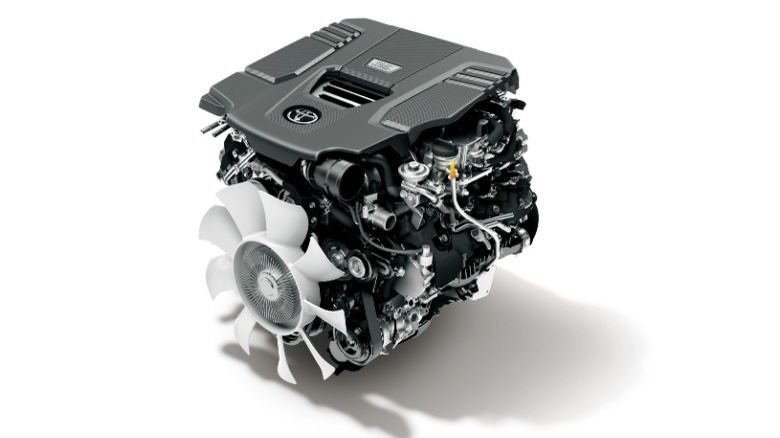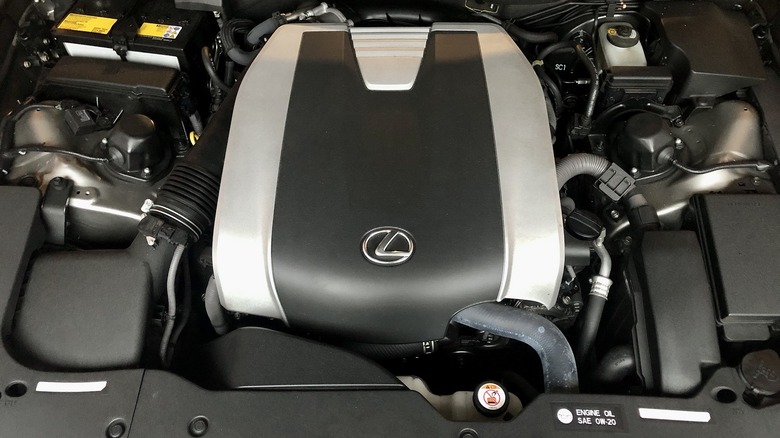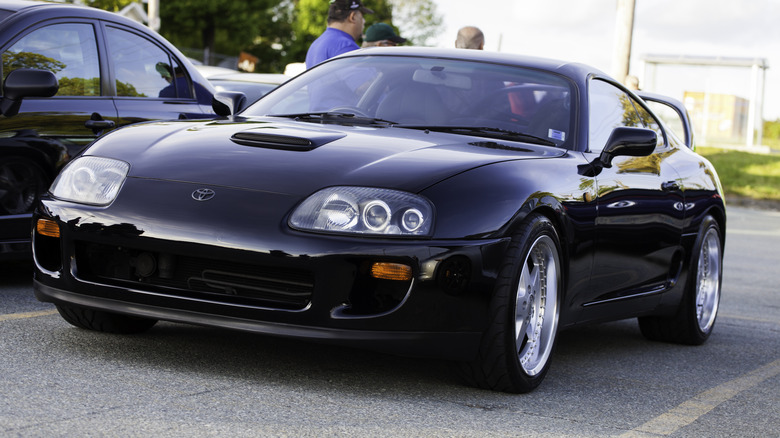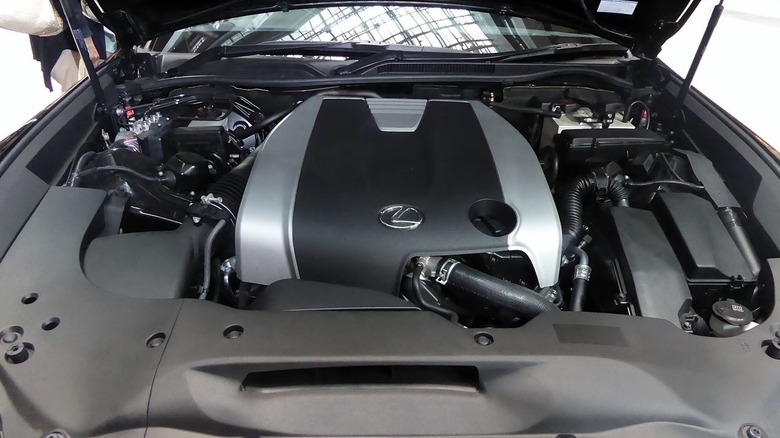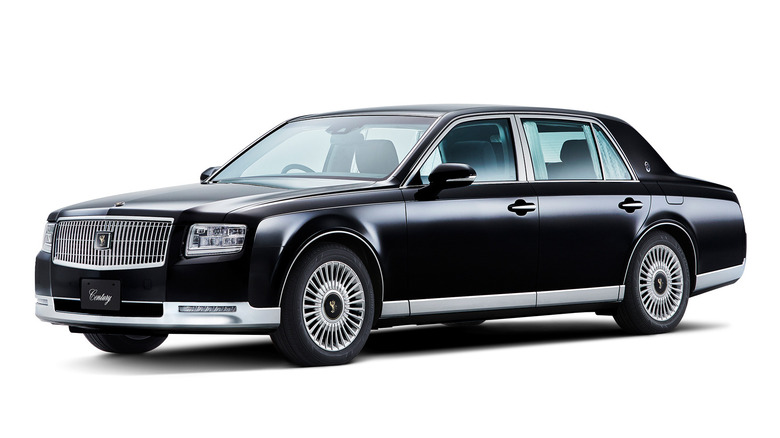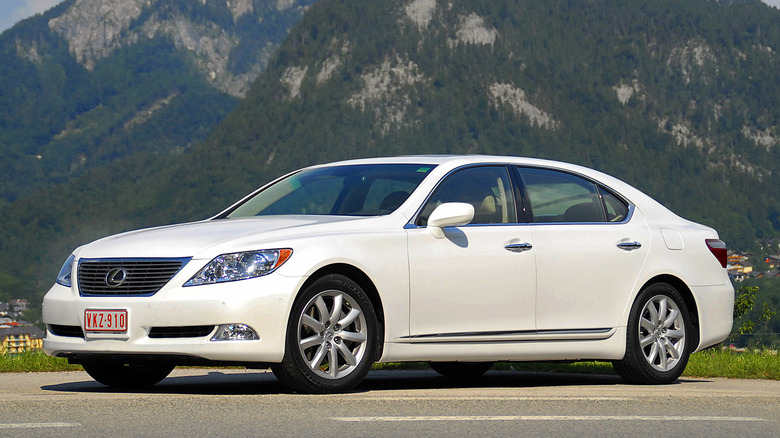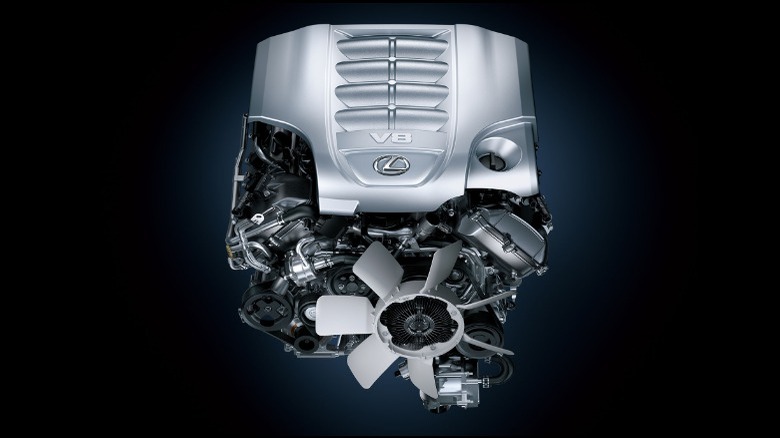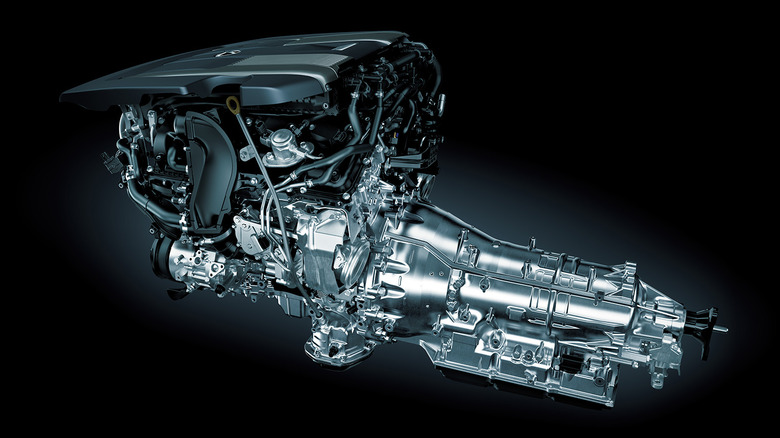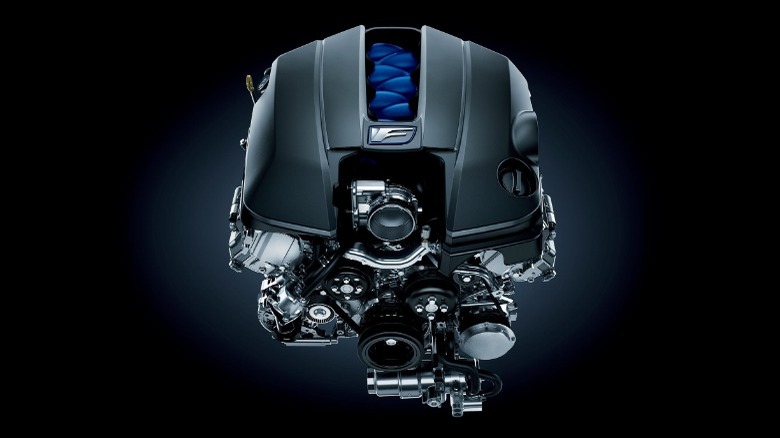Toyota's 10 Highest Horsepower Engines Ever Built, Ranked
Toyota's position as one of the largest automakers in the world is a hard-earned one. Chiefly, it got there by spending decades building reliable, practical, and affordable cars, at the heart of which sat some of the most durable engines on the market. There's a reason that reliability surveys consistently rank the Toyota and Lexus brands among the best overall — the automaker has focused meticulously on quality over the years, delivering powerplants that can handle decades of hard work without complaint.
However, as well as being just durable, Toyota's powerplants have become increasingly potent over the years too. A few decades ago, the brand's unwritten agreement with other Japanese manufacturers saw it officially limiting its cars to 276 horsepower, but since then, the gloves have come off, and power figures have risen significantly.
We've rounded up ten of the most powerful Toyota engines to date, ranked by their horsepower outputs. To keep things simple, we've only included engines built in-house by Toyota — so the Toyota-based units found in Lotus cars don't count — and we've also only counted output from combustion engines. Toyota is renowned for its hybrids, but for the purpose of this list, we're only considering the output of a car's gas engine alone, not its combined hybrid power output.
Toyota F33A-FTV -- 304 horsepower
The 300 Series Land Cruiser isn't sold in the U.S., although its Lexus-branded counterpart, the LX600, is offered. Despite being generally very similar underneath, the Lexus misses out on the F33A-FTV engine that's available in certain markets for the latest full-fat Land Cruiser. It's a 3.3L twin-turbo diesel V6 that produces 304 horsepower and 516 lb-ft of torque. Toyota says that the two turbochargers allow for more rapid acceleration than in previous Land Cruiser generations, while still retaining plenty of low-end grunt for towing or crawling over rough terrain.
The engine is mated to a 10-speed automatic transmission in all 300 Series Land Cruisers, regardless of whether they're diesel- or gas-powered. A GR Sport model pays tribute to Toyota's Dakar rally heritage, adding revised suspension and a new front differential lock. However, power output remains unchanged.
While U.S. buyers miss out on the 300 Series Land Cruiser, the smaller 250 Series was unveiled in 2023 and has made it to American shores. However, there's no diesel option offered stateside for the 250 either, despite one being available in other markets.
Toyota 2GR-FKS -- 311 horsepower
The 2GR-FKS 3.5L V6 engine can be found across a wide variety of Toyota and Lexus models, and in its most powerful configuration, produces 311 horsepower. Multiple 2024 model year Lexus cars feature the engine, including the IS 350 sedan. For 2024, the IS 350 is available in either rear-wheel drive or all-wheel drive form, with the former featuring an eight-speed automatic transmission and the latter only available with a six-speed auto. Across both variants, the car's ULEV certification ensures emissions are below the industry average.
Among the other models the 2GR-FKS can also be found in is the RC 350, which features more athletic styling and loses a pair of doors compared to the sedan. In both cars, the V6 serves as a midrange option, with a turbo four-cylinder engine offered as the entry point and a 5.0L V8 offered as the range-topping option. The engine's performance figures tally with that middle-ground appeal — in the IS 350, it translates to a 5.6-second 0-60 mph time and a top speed of 143 mph. So it's no slouch, but way off what the sportiest powerplants in the segment can offer.
[Featured image by Sixaxis666 via Wikimedia Commons | Cropped and scaled | CC BY-SA 4.0]
Toyota 2JZ-GTE -- 320 horsepower
Many enthusiasts might expect the legendary 2JZ-GTE to appear higher up in the rankings, as it's famous for being extremely tunable. However, in stock form, Toyota only ever officially claimed the engine's output to be 320 horsepower. That was only for export models too — JDM Supras were rated at just 276 horsepower, thanks to a tacit agreement between the country's biggest carmakers.
Of course, it's widely acknowledged that the true output of these over-engineered powerplants is higher than their official figures, and can be drastically increased with just a few simple modifications. In fact, outputs stretching well into the four-figure range are more attainable to project builders than ever, thanks to the huge aftermarket that surrounds the engine today.
While the engine was only ever sold in export markets in the turbo MkIV Supra, it was also available in the JDM Toyota Aristo. As a result, these luxury family sedans have become a cult favorite with drifters and project car builders looking to avoid paying the high prices that Supra Turbos now command.
Toyota 2GR-FSE -- 355 horsepower
Toyota's in-house tuning division, Modellista, has produced a variety of local specialties for the Japanese market, including a supercharged version of the 2GR-FSE V6 engine. It was sold only in the Mark X +M Supercharged sedan, which launched in 2009 and featured unique sports suspension alongside its upgraded engine. With the Modellista-fitted supercharger and an upgraded ECU, the top-spec 2GR-FSE could churn out 355 horsepower. However, at a starting price of over 5.3 million Yen (around $56,600 at the time), it cost a steep 76% premium over base-spec Mark X models.
Alongside the Toyota Mark X, the 2GR-FSE also appeared in a number of other Toyota and Lexus models, albeit in a less potent naturally aspirated guise. One of the most recent American-market models to feature the engine is the 2017 RC Coupe, specifically in the RC 300 and RC 350 variants. In the RC 350, it produced 306 horsepower and 277 lb-ft of torque. A refresh of the RC lineup in 2018 saw it replaced by the aforementioned 2GR-FKS V6.
[Featured image by Tokumeigakarinoaoshima via Wikimedia Commons | Cropped and scaled | CC0 1.0]
Toyota 2UR-FSE -- 375 horsepower
It should come as a surprise to no one that Toyota's V8 engines consistently rank among its most powerful mills to date. In particular, the UR line makes several appearances on this list, the first of which being the 2UR-FSE that's found in the current generation Toyota Century sedan. The third-generation Century was unveiled in 2018 and was the first major refresh the model has seen in more than two decades.
The previous generation featured a V12 engine — the first ever V12 in a Japanese production car — but the new Century ditched that engine in favor of a hybrid V8 setup. The car makes a combined 425 horsepower with both its electric and gas motor, with the 2UR-FSE on its own making 375 of those horses.
The Century is designed for Japanese officials and wealthy businesspeople and serves as a more understated alternative to the likes of Bentley and Rolls-Royce. It's produced in extremely limited numbers and features similarly palatial rear seats to its British counterparts. A variety of bespoke options are available, although each car benefits from a level of craftsmanship far beyond any regular Toyota as standard. Just the phoenix emblem on the car takes a single craftsman six weeks to make by hand. The V8 powerplant is also assembled with the same forensic attention to detail, making it one of Toyota's most dependable V8 engines, as well as one of its most powerful.
Toyota 1UR-FSE -- 380 horsepower
Another UR V8 variant, the 1UR-FSE, was only available in America in Lexus' luxury sedans. The 4.7L engine was first unveiled in the flagship LS 460 sedan in 2007, boasting 380 horsepower and 370 lb-ft of torque. Despite being a heavy, imposing luxury barge, the LS 460 could reach 0-60 mph in just 5.5 seconds. The car was only available with rear-wheel drive, with the engine connected to the wheels via an eight-speed automatic transmission.
As well as debuting a new engine, the LS 460 debuted a new styling language that Lexus called "L-finesse." Still one of the more conservative-looking luxury cars compared to offerings from German market leaders like BMW and Audi, the LS was nonetheless significantly updated both inside and out. While the mid-'00s car was far from a radical departure from its predecessor, it helped cement Lexus as a genuine contender against the biggest players in the segment, both in terms of design and performance.
Toyota 3UR-FE -- 381 horsepower
Debuting in the 2007 Tundra pickup, the 3UR-FE was designed to take on the best-selling American V8 pickups on their home turf. It also appeared in a variety of other models, including the Toyota Land Cruiser, Sequoia, and Lexus LX SUVs, and remained in production until the second-gen Tundra's last model year in 2021. The reason for its longevity was simple: The 3UR-FE did exactly what it set out to do, rivaling American engines both in terms of power and durability. In standard form, it made 381 horsepower and 401 lb-ft of torque, and it was just as reliable as Toyota buyers expected.
Its 5.7L displacement was on par with its main competitors when it first launched, although throughout its later years of production, a lack of updates meant that it was neither the most efficient nor the most powerful in its segment. Still, it remained a popular choice among buyers until it was phased out in favor of a new six-cylinder unit that debuted with the third-generation Tundra.
Toyota V35A-FTS -- 415 horsepower
The Tundra six-cylinder in question is the 3.5L V35A-FTS, which first debuted in the Lexus LS 500 in 2018. It offered 415 horsepower and 442 lb-ft of torque, alongside a newly developed ten-speed automatic transmission. The flagship sedan proved to be quicker off the line than its V8-powered predecessor, with an officially quoted 0-60 mph time of 4.5 seconds for the rear-wheel drive model.
Despite being down two cylinders compared to the previous LS' engine, the V35A-FTS's improved power figures were in no small part thanks to the twin turbochargers crammed under the sloping hood. The same setup is employed in the 2024 Tundra, although there it produces 389 horsepower and an improved 479 lb-ft of torque. It can also be paired with an additional electric motor for a combined output of 437 horsepower, and an even more impressive 583 lb-ft of torque. However, since we've excluded electric motor outputs for ranking purposes, the LS sedan still features the highest horsepower version of the engine to date.
Toyota 2UR-GSE -- 472 horsepower
The most powerful of the UR V8 engine family is the 5.0L 2UR-GSE, which features in several performance Lexus models, including the RC F. It's the brand's most powerful production V8 to date, with 472 horsepower on offer. In the RC F, it propels the car from a standstill to 60 mph in just 4.2 seconds. It's also available in the range-topping 2024 IS 500 sedan, packing an identical number of horses. However, the added weight of the sedan means that 0-60 mph is reduced slightly to 4.4 seconds.
The top speed of the IS 500 is a few ticks short of many of its German rivals, clocking in at 149 mph. However, it's also more efficient than most of them, too. A combined figure of 20 mpg is nothing to sniff at considering the power involved, although anyone on the hunt for the best economy will need to sacrifice a few horsepower and opt for the more frugal IS 350, which packs the 2GR-FKS featured earlier on this list.
Toyota 1LR-GUE -- 563 horsepower
Still topping the table as the most powerful Toyota production engine ever built is the 4.8L 1LR-GUE V10, which was developed specifically for the Lexus LFA supercar. In standard guise, it produced 553 horsepower, but in the ultra-limited LFA Nürburgring Package that figure was upped to 563 horsepower. The engine was the result of years of development and was designed in collaboration with Yamaha.
It makes liberal use of cutting-edge alloys previously reserved for motorsport, and as a result, is both lighter and smaller than a conventional V10 engine. That lightweight, racing-inspired philosophy was reflected in the LFA's design as a whole, helping it achieve some remarkable performance figures. It took just 3.7 seconds for the LFA to reach 62 mph from a standstill, and boasted a 9,000 rpm redline.
Its top speed was officially quoted as 202 mph, but even more impressive was the soundtrack it produced while getting there. As well as being the most powerful Toyota engine ever made, the 1LR-GUE was undoubtedly one of the best sounding. Although, with rumors suggesting the LFA's successor will be at least partly electrified, it may well be the first and last of its kind.
